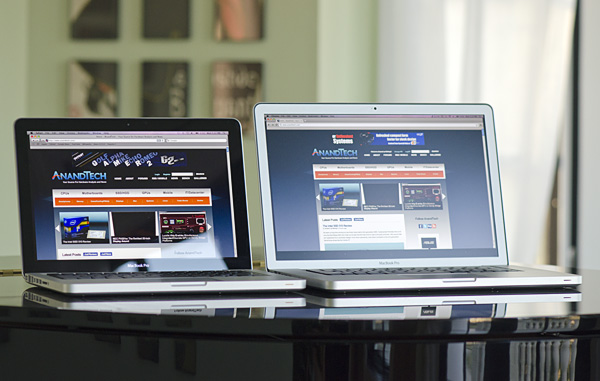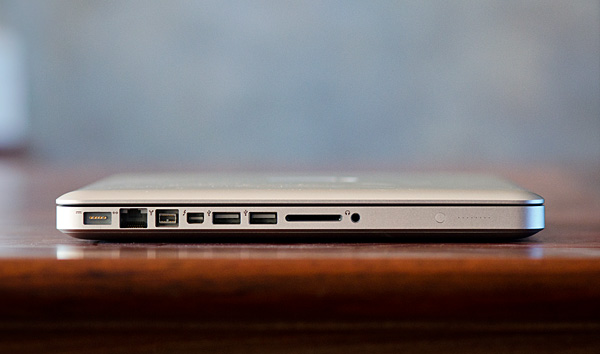The MacBook Pro Review (13 & 15-inch): 2011 Brings Sandy Bridge
by Anand Lal Shimpi, Brian Klug & Vivek Gowri on March 10, 2011 4:17 PM EST- Posted in
- Laptops
- Mac
- Apple
- Intel
- MacBook Pro
- Sandy Bridge
Final Words
For as little attention as the 2011 MacBook Pro launch was given by Apple, there sure is a lot to talk about.
The advantages are numerous. With the 13-inch MacBook Pro, under OS X at least, there simply aren't any downsides. You get much better CPU performance over the previous generation. In fact, the new 13 can outperform last year's 15 thanks to Sandy Bridge. The new 13 is quite possibly the best balance of portability and performance. It's the single largest upgrade you'll find in the lineup. If you own a previous generation 13-inch MBP, the upgrade is 100% worth it. Graphics performance is solid under OS X however questionable under Windows. For some reason we actually saw a step back in GPU performance vs. last year's 13-inch MBP when running games in Windows 7.
The 15-inch MacBook Pro is a beast. Although it comes in the same chassis as last year's model, it delivers much more performance. The move to quad-core Sandy Bridge makes the 15-inch MacBook Pro's performance formidable. Whereas I couldn't use the 2010 15 as my primary work machine, with an SSD the 2011 15-inch MBP does just fine.
Displays haven't really changed, which is both good and bad. On the one hand, Apple's MacBook Pros have always used good quality panels. On the other hand I'd like to see a higher res option for the 13-inch display—1280 x 800 is a big turnoff for me with the 13-inch model.
Thunderbolt is a nice addition however I expect that it'll be grossly underused for a while. We'll see some nice Thunderbolt enabled external storage solutions this Spring (helping perpetuate the mobile desktop usage model), but it'll be a while before we get the single-cable carrying USB, Ethernet, FireWire and DisplayPort to a display.
The WiFi improvements are welcome, although surprisingly absent from Apple's marketing collateral. The front facing 720p camera is also a nice touch.
It's not all rosy however. Apple fails to really take advantage of one of Sandy Bridge's biggest features: Quick Sync. The hardware encoder is used in FaceTime HD but you still get some very high CPU usage (at least of a single core). There's no support in QuickTime or iMovie 2011 for Quick Sync as of now, which is a major disappointment.
I mentioned that the 15-inch MacBook Pro is easily a desktop replacement, however you do have to deal with a loud fan under heavier CPU loads. Something a well designed desktop won't bother you with.
SSD support is still problematic. There are far too many reports of drives that don't work properly in the 2011 MacBook Pro, and Apple refuses to validate/ship anything but fairly mainstream SSD solutions. To make matters worse, although TRIM is finally enabled under OS X—it only works on Apple branded SSDs. I can understand Apple's desire to want to avoid dealing with the pitfalls of early SSDs with questionable firmware maturity, but I also believe it's Apple's duty to support as much hardware that's out there in the market today. If Apple offered something with SandForce SF-2200 class performance I'd have less of a bone to pick, but presently it doesn't.
Then there are the concerns about battery life. Under light usage there's a clear improvement over last year's models. The new 15-inch MacBook Pro is good for anywhere between 7—9 hours of light usage. That is assuming you don't have the dGPU running of course, at which point you should start talking about numbers below 5 hours. Even without the discrete GPU enabled, in the hands of a multitasker the new 15-inch MacBook Pro can easily burn through its 77Whr battery quicker than last year's model. While our worst case numbers don't look much lower than the 2010 model, the chances of you getting less than 2.5 hours out of the new 15 are much higher than they were last year.
The new 13-inch model is less of a concern when it comes to battery life. It's still got a 35W TDP dual-core CPU and no discrete GPU to sap power. It's the move to four cores and the additional GPU that really hurt the 15-inch MacBook Pro under heavy usage.
Overall the new lineup is a significant step forward. As I mentioned earlier, if you're in the market for a 13-inch system the 2011 Sandy Bridge MacBook Pro is likely the one to get. The 15 is just as easy to recommend, provided you're ok with the downsides (higher temperatures, louder fans, shorter battery life under load). If you aren't ok with the downsides, just wait another year and get the Ivy Bridge based successor.












198 Comments
View All Comments
jb510 - Friday, March 11, 2011 - link
It would seem to me their is one currently shipping Thunderbolt periphral... A 2011 MBP in target disk mode. Maybe you could drop an SSD in one and do some preliminary testing?jb510 - Friday, March 11, 2011 - link
damn... wish i could edit that comment originally typed on my iphone... but their doesn't appear to be any way... (misspelling repeated for comedic effect)deadshort - Friday, March 11, 2011 - link
Thanks for the genuinely informative review. Running both low-load and high-load battery tests is especially helpful to developers, etc.One question. You chose the 2.3Ghz/8MB cache system. Was that just 'cuz you swing that way, or do you expect significant performance benefits for some workload you care about? For these machines is it a 10% price goldplate, or a reasonable increment to keep these CPUs fed? I am seriously interested....
Brian Klug - Friday, March 11, 2011 - link
I can speak for myself at least, but part of the reason for the 2.3/8 MB system choice was that it's the only preconfigured (Apple Store available) configuration that comes with the anti-glare display.Essentially, if you're a customer walking into the apple store and don't want the glossy/glare display, you're immediately forced into buying the highest-specced (and most expensive) MacBook Pro. It's frustrating because the only way to get lower specced systems is BTO online.
Obviously we got these systems on launch date to immediately start working, and that was the reason for the 2.3 choice.
-Brian
synaesthetic - Friday, March 11, 2011 - link
You know, I don't get this thin crap. I really don't.I mean, I can understand it. From a purely aesthetic point of view. Sort of, anyway.
I'm sick of "thin" gadgets with weak performance and fragile builds. Thick gadgets means more tech fits inside. My HTC Glacier is quite thin, and you know what? I wish it was thicker. It'd be easier to hold onto, and HTC could have put a bigger battery in it!
Stop making things so stupidly thin. Instead of driving the miniaturization of components on "thin," why not take that same miniaturization power and make things a bit thicker... with more power/cooling/battery inside?
Thin may be sexy, but powerful is even sexier!
Then again, Apple's never really cared to broadcast the specs of their devices, hoping instead to gloss over it to such a degree that nobody questions paying ridiculously inflated prices...
Marc B - Friday, March 11, 2011 - link
I am finally buying my first MacBook this year, and I am 70/30 leaning toward the 15" MBP. The 17" version has the high res screen and express port, but the 15" MBP is lighter/smaller and has the SDXC reader. Will the Thunderbolt port will provide enough throughput to allow simultaneous in/out?I am using this to log HD video on location, and was wondering if the express port is no longer necessary to use with a small ESATA array now that you can have high speed storage in and out using the Thunderbolt port.
Belard - Friday, March 11, 2011 - link
If Apple is pushing their notebooks to be more and more Desktop replacements...Where is a docking bay to handle all the connectors? How hard for a single connector to handle everything?
Lenovo sells about 3 different Docking units $130~300 for their regular Thinkpad line (ie: NOT Edge or L/SL series).
We have a few users who use them. Comes to the office, drop the notebook into the dock and turn it on, not a single cable to be attached. They include 4 USB ports (or more), PS/2 ports, HDMI and DVI ports, Ethernet and of course charge up the battery.
So one user would have to plug in 7 cables everyday if he didn't have a dock... like his keyboard, wireless desktop mouse, 21" display, various printers and devices, etc.
name99 - Friday, March 11, 2011 - link
" I still haven't figured out how to actually grab SINR out on here, all I can see for the moment is just RSSI. "Apple's Airport Utility does give you part of what you want.
If you open it, go to "Manual Setup", see the summary page, and click on where it says "Wireless Clients: 2" (or 3 or whatever) you will be given a page that, for each connection, shows their signal and noise levels (along with a graph).
Of course this doesn't exactly have any bearing on what we are discussing, because the numbers that are presented are the intermediate term SINR values, relevant to shadowing but not to fading. The numbers that are relevant to fading (and thus to MIMO tricks) change on a millisecond time scale, and so what one really wants is an indication of their standard deviation, along with other info like the connection diversity. This is all way more geeky than Apple (or any other consumer company) is going to provide.
humunculus - Friday, March 11, 2011 - link
Any chance you could run a few of the tests on the 2.0 and 2.2 GHz models. I am interested in how much performance difference there is between the 2.2 and 2.3 GHz 15 inch Macbook Pro models. It is hard to assess if the 10% cost increase is warranted. ThanksBelard - Saturday, March 12, 2011 - link
The $400 price difference is for the extra 200mhz (Apple values that at $250 - these are notebook CPUs, so pricing from intel is a factor)And then $150 to sometimes double the performance of the GPU for games.
Oh, and an extra 250GB of HD space (which is about $5 in the real world).